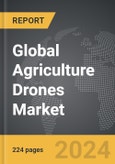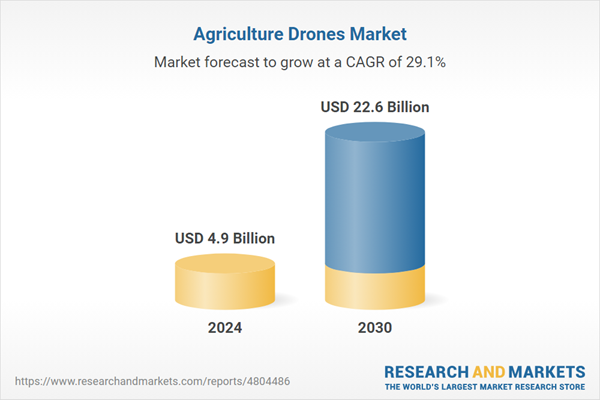The global market for Agriculture Drones was valued at US$4.9 Billion in 2024 and is projected to reach US$22.6 Billion by 2030, growing at a CAGR of 29.1% from 2024 to 2030. This comprehensive report provides an in-depth analysis of market trends, drivers, and forecasts, helping you make informed business decisions. The report includes the most recent global tariff developments and how they impact the Agriculture Drones market.
The integration of various technologies has significantly enhanced the utility of agricultural drones. For instance, multispectral imaging technology allows drones to capture data not visible to the naked eye, helping to assess plant health by measuring the absorption and reflection of different light wavelengths. This information is vital for early disease and pest detection. Drones equipped with thermal cameras can assess water stress levels in crops, and those with AI capabilities can automate and optimize route planning for spraying and monitoring tasks. The continuous improvement in battery technology and drone hardware also means these UAVs can cover larger areas more efficiently and with greater load capacities, allowing for more extensive use in different types of agricultural activities. Additionally, the software that processes the data collected by drones is becoming increasingly sophisticated, providing actionable insights that can be directly applied to improve farming practices.
The growth in the agriculture drone market is driven by several factors, including technological advancements, the increasing adoption of precision farming techniques, and economic pressures to increase crop yield amidst global food demand. As the global population continues to grow, so does the demand for food production, which encourages the adoption of innovative technologies to enhance farm productivity. Drones reduce the time and labor required for tasks like crop surveying and data collection, making farm operations more efficient and less labor-intensive. Additionally, environmental concerns and regulatory changes regarding pesticide use have pushed the farming industry towards more sustainable practices, further fueling the adoption of drones for precise pesticide application, reducing run-off and environmental impact. The availability of high-resolution aerial imagery also supports better crop management and soil health practices, essential for sustainable agriculture. Furthermore, governmental support and subsidies in various countries to adopt modern agricultural techniques have made these technologies accessible to a broader range of farmers, enhancing market growth. These drivers ensure that the adoption of agriculture drones will continue to expand, reflecting their growing importance in the global agricultural industry.
Segments: Type (Hardware, Software); Application (Crop Spraying, Field Mapping, Crop Scouting, Livestock, Variable Rate Application, Other Applications).
Geographic Regions/Countries: World; USA; Canada; Japan; China; Europe; France; Germany; Italy; UK; Rest of Europe; Asia-Pacific; Rest of World.
The analysts continuously track trade developments worldwide, drawing insights from leading global economists and over 200 industry and policy institutions, including think tanks, trade organizations, and national economic advisory bodies. This intelligence is integrated into forecasting models to provide timely, data-driven analysis of emerging risks and opportunities.
Global Agriculture Drones Market - Key Trends & Drivers Summarized
Agriculture drones, or unmanned aerial vehicles (UAVs), represent a significant technological advancement in modern farming techniques. These drones are increasingly being used to enhance various agricultural practices including crop monitoring, field analysis, plant spraying, and precise mapping to boost productivity while minimizing labor and resources. Equipped with advanced sensors, GPS, and imaging capabilities, agriculture drones can collect data on crop health, moisture levels, and soil variation across vast areas more efficiently than traditional methods. This data is crucial for precision farming, where it is used to make informed decisions regarding planting, watering, and pesticide application. By providing a bird's-eye view of the field, drones help farmers identify problematic areas, ensuring targeted intervention and thereby reducing waste and enhancing the crop yield.The integration of various technologies has significantly enhanced the utility of agricultural drones. For instance, multispectral imaging technology allows drones to capture data not visible to the naked eye, helping to assess plant health by measuring the absorption and reflection of different light wavelengths. This information is vital for early disease and pest detection. Drones equipped with thermal cameras can assess water stress levels in crops, and those with AI capabilities can automate and optimize route planning for spraying and monitoring tasks. The continuous improvement in battery technology and drone hardware also means these UAVs can cover larger areas more efficiently and with greater load capacities, allowing for more extensive use in different types of agricultural activities. Additionally, the software that processes the data collected by drones is becoming increasingly sophisticated, providing actionable insights that can be directly applied to improve farming practices.
The growth in the agriculture drone market is driven by several factors, including technological advancements, the increasing adoption of precision farming techniques, and economic pressures to increase crop yield amidst global food demand. As the global population continues to grow, so does the demand for food production, which encourages the adoption of innovative technologies to enhance farm productivity. Drones reduce the time and labor required for tasks like crop surveying and data collection, making farm operations more efficient and less labor-intensive. Additionally, environmental concerns and regulatory changes regarding pesticide use have pushed the farming industry towards more sustainable practices, further fueling the adoption of drones for precise pesticide application, reducing run-off and environmental impact. The availability of high-resolution aerial imagery also supports better crop management and soil health practices, essential for sustainable agriculture. Furthermore, governmental support and subsidies in various countries to adopt modern agricultural techniques have made these technologies accessible to a broader range of farmers, enhancing market growth. These drivers ensure that the adoption of agriculture drones will continue to expand, reflecting their growing importance in the global agricultural industry.
Report Scope
The report analyzes the Agriculture Drones market, presented in terms of units. The analysis covers the key segments and geographic regions outlined below.Segments: Type (Hardware, Software); Application (Crop Spraying, Field Mapping, Crop Scouting, Livestock, Variable Rate Application, Other Applications).
Geographic Regions/Countries: World; USA; Canada; Japan; China; Europe; France; Germany; Italy; UK; Rest of Europe; Asia-Pacific; Rest of World.
Key Insights:
- Market Growth: Understand the significant growth trajectory of the Crop Spraying segment, which is expected to reach US$10.4 Billion by 2030 with a CAGR of a 31.0%. The Field Mapping segment is also set to grow at 29.7% CAGR over the analysis period.
- Regional Analysis: Gain insights into the U.S. market, valued at $1.5 Billion in 2024, and China, forecasted to grow at an impressive 33.4% CAGR to reach $4.1 Billion by 2030. Discover growth trends in other key regions, including Japan, Canada, Germany, and the Asia-Pacific.
Why You Should Buy This Report:
- Detailed Market Analysis: Access a thorough analysis of the Global Agriculture Drones Market, covering all major geographic regions and market segments.
- Competitive Insights: Get an overview of the competitive landscape, including the market presence of major players across different geographies.
- Future Trends and Drivers: Understand the key trends and drivers shaping the future of the Global Agriculture Drones Market.
- Actionable Insights: Benefit from actionable insights that can help you identify new revenue opportunities and make strategic business decisions.
Key Questions Answered:
- How is the Global Agriculture Drones Market expected to evolve by 2030?
- What are the main drivers and restraints affecting the market?
- Which market segments will grow the most over the forecast period?
- How will market shares for different regions and segments change by 2030?
- Who are the leading players in the market, and what are their prospects?
Report Features:
- Comprehensive Market Data: Independent analysis of annual sales and market forecasts in US$ Million from 2024 to 2030.
- In-Depth Regional Analysis: Detailed insights into key markets, including the U.S., China, Japan, Canada, Europe, Asia-Pacific, Latin America, Middle East, and Africa.
- Company Profiles: Coverage of players such as Yamaha Motor Co., Ltd., AGCO Corporation, AeroVironment, Inc., AgEagle Aerial Systems, Inc., SZ DJI Technology Co., Ltd. and more.
- Complimentary Updates: Receive free report updates for one year to keep you informed of the latest market developments.
Some of the 44 companies featured in this Agriculture Drones market report include:
- Yamaha Motor Co., Ltd.
- AGCO Corporation
- AeroVironment, Inc.
- AgEagle Aerial Systems, Inc.
- SZ DJI Technology Co., Ltd.
- Delair
- microdrones GmbH
- Aeronavics Ltd.
- Draganfly Inc.
- Yamaha Motor Corporation
- AgroFly SA
- NEWAGCO Inc.
Tariff Impact Analysis: Key Insights for 2025
Global tariff negotiations across 180+ countries are reshaping supply chains, costs, and competitiveness. This report reflects the latest developments as of April 2025 and incorporates forward-looking insights into the market outlook.The analysts continuously track trade developments worldwide, drawing insights from leading global economists and over 200 industry and policy institutions, including think tanks, trade organizations, and national economic advisory bodies. This intelligence is integrated into forecasting models to provide timely, data-driven analysis of emerging risks and opportunities.
What’s Included in This Edition:
- Tariff-adjusted market forecasts by region and segment
- Analysis of cost and supply chain implications by sourcing and trade exposure
- Strategic insights into geographic shifts
Buyers receive a free July 2025 update with:
- Finalized tariff impacts and new trade agreement effects
- Updated projections reflecting global sourcing and cost shifts
- Expanded country-specific coverage across the industry
Table of Contents
I. METHODOLOGYII. EXECUTIVE SUMMARYIII. MARKET ANALYSISIV. COMPETITION
1. MARKET OVERVIEW
2. FOCUS ON SELECT PLAYERS
3. MARKET TRENDS & DRIVERS
4. GLOBAL MARKET PERSPECTIVE
UNITED STATES
CANADA
JAPAN
CHINA
EUROPE
FRANCE
GERMANY
ITALY
UNITED KINGDOM
REST OF EUROPE
ASIA-PACIFIC
REST OF WORLD
Companies Mentioned (Partial List)
A selection of companies mentioned in this report includes, but is not limited to:
- Yamaha Motor Co., Ltd.
- AGCO Corporation
- AeroVironment, Inc.
- AgEagle Aerial Systems, Inc.
- SZ DJI Technology Co., Ltd.
- Delair
- microdrones GmbH
- Aeronavics Ltd.
- Draganfly Inc.
- Yamaha Motor Corporation
- AgroFly SA
- NEWAGCO Inc.
Table Information
| Report Attribute | Details |
|---|---|
| No. of Pages | 224 |
| Published | April 2025 |
| Forecast Period | 2024 - 2030 |
| Estimated Market Value ( USD | $ 4.9 Billion |
| Forecasted Market Value ( USD | $ 22.6 Billion |
| Compound Annual Growth Rate | 29.1% |
| Regions Covered | Global |









